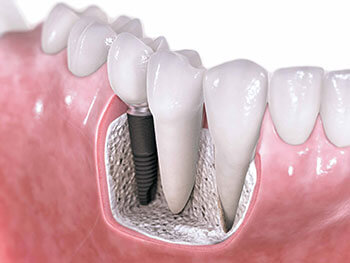
Dental implants are man-made roots made out of titanium metal that are secured into your jaw bone. A man-made tooth is permanently secured onto this artificial root. Similar to natural teeth, they look and feel the same and must be taken care of by the same home care techniques including brushing, flossing, as well as regularly scheduled dental visits.
The implant procedure actually consists of two stages:
The placement stage refers to the placement of the surgical metal post into your jaw that will replace a tooth or root and allow a fixture or restoration of your real tooth to be secured to it.

There are many advantages to dental implants. Including:
Lost teeth due to periodontal disease do not keep you from having dental implants. It is important to note that in some cases, additional bone is needed in to secure the implant. If this is required, a dentist can treat it by grafting and regenerating any lost bone to the area. Implants can be placed when a sufficient amount of bone has regenerated in the area.
X-ray images and an examination by the dentist can determine whether you have the right amount of existing bone to support dental implants.
Implants have a high success rate of over 95 per cent. However, some risks exist that you should be aware of. Infection can occur, in rare cases, but this is solved with antibiotics. Occasionally implant rejection, numbness and/or pain that does not go away can occur.
When an implant rejects, is not the same as the "rejection" of organ transplants. Dental implants are compatible with the body and no cases of allergic reactions has occured in the use of implants that are commercially-pure titanium. But it's important to note that failures can happen.
If a dental implant "fails" or is "rejected" it is usually because of infection. Implants can be contaminated by bacteria which may cause the implant to reject or be "lost." Victoriapark Dental dentists employ the highest standards in ensuring sterile conditions during the treatment. This begins wih how the implant is packaged to the overall sterile conditions of the operating room.
Almost always, a second implant can be attempted in the same location of the failed implant. Even if we can't confirm why an implant has failed, we are able to remove it safely and preparethe area for another implant. Your dentist will determine whether it is safe to do quite soon, or if more healing time is advised before attempting again. Second attempts are usually very successful following a previous implant failure.
First, your dentist will examine your mouth and may take an x-ray to determine whether you have enough bone to support a dental implant.
When sufficient bone exists, the implant is secured into either the maxillary bone (for upper implant restoration) or jawbone (for lower implant restoration). This procedure typically takes an hour or less.
Following placement of the implant, the bone will need sufficient time to heal, which can take up to 20 weeks.
Once the implant is completely integrated and the bone has healed, the restoration (e.g., crown, bridge, denture) can be secured to the implant.
Implants must be taken care of, similar to natural teeth, by brushing, flossing and visiting your dentist for regular checkups. They are very durable and can last for many years, if not an entire lifetime.
Depending on where the implant will be placed, it may be necessary to increase the amount of bone through one of the following three procedures:
If you need a restoration, it describes the crown, bridge or denture that are secured onto the implant post that has previously been placed into your jaw to replace your natural tooth and root that is no longer there.
With our highly-precise, digital imaging system, iTero, we scan an impression of the inside of your mouth, allowing the lab to create a crown, bridge or denture, that fits your mouth perfectly.
Once a dental implant has been placed, has healed, and has integrated, implant restorations can then take place.
If there is a gap between two teeth due to a missing tooth between, the surrounding teeth with naturally shift towards the gap, often causing misalignment of the facial structure and TMJ disorders (temporomandibular). This also can causes issues such as difficulty chewing, gum disease, and bone loss.
To prevent these negative results, an implant restoration should be considered, as it aids in the correction of the patient’s bite to ensure evenly distributed pressure. It also helps to improve the straightness, shape, and aesthetics of the patient’s teeth.

The first step is for the implant to be placed. Once this happens, it can take up to 20 weeks for the bone and surrounding tissues to heal and integrate the implant.
After the implant has integrated and healed, the patient’s mouth is then scanned with iTero technology. iTero produces a digitally scanned image and impression of the patient’s mouth, ensuring that the restoration will be a perfect fit.
The implant restoration (denture, bridge, or crown) is then fabricated at a dental laboratory using the impressions that were taken. Once we have received the implant restoration back from the laboratory, we install it into your mouth via the dental implant.
Implants still require regular maintenance, just like your regular teeth, by proper flossing, brushing, and hygiene appointments. Implants are often able to last for an entire lifetime. At Victoriapark Dental, Patient Care Specialists will provide answers for any questions or concerns you may have throughout the treatment process. You may also consult a dentist withy our questions or concerns during a free consultation.
Sometimes in order to successfully place an implant, a more complex procedure may be required. At our office we have dentists and specialists to ensure that these procedures can be completed: